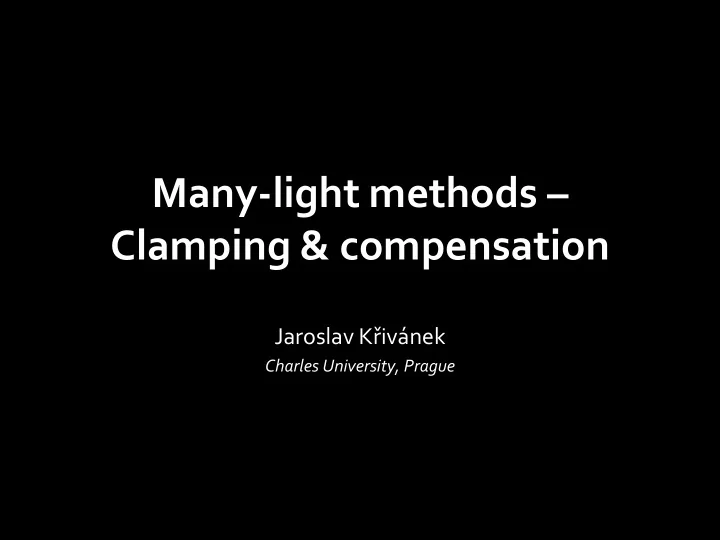

Many-light methods – Clamping & compensation Jaroslav Křivánek Charles University, Prague
Instant radiosity • Approximate indirect illumination by 1. Generate VPLs 2. Render with VPLs 2
Clamping 1000 VPLs - no clamping 1000 VPLs - clamping reference (path tracing) missing energy 3
Clamping Compensation Kollig & Keller, MCQMC 2004
Idea • Clamping reduces variance but some energy is lost • Find formula for the lost energy • Compute the lost energy by selective path tracing path tracing compensation clamping full solution 5
Clamping VPL power VPL emission distribution (BRDF lobe at p – for a diffuse VPL can be folded into Φ ) min{ c, } Geometry term Visibility p ω o x 6
Formal derivation • Clamping evaluates this equation • Can be written as 7
What’s missing? • Unbiased solution Path tracing VPLs w/ clamping compensation of the clamped energy 8
Result • Compensation faster than path tracing everything (many path terminated early) path tracing compensation clamping full solution 9
Biased result with clamping 10
Unbiased result with compensation 11
Dealing with Glossy Transport
Instant radiosity with glossy surfaces Ground truth 1,000 VPLs 100,000 VPLs 13
Effect of clamping 14
Virtual Spherical Lights Ha šan, Křivánek & Bala, SIGGRAPH Asia 2009
Emission distribution of a VPL • Cosine - weighted BRDF lobe at the VPL location Glossy Diffuse 16
Glossy VPL emission: illumination spikes Common solution: Only diffuse BRDF at light location 17
Remaining spikes 18
Remaining spikes • VPL contribution = VPL power . BRDF( x ) . cos( x ) . 1 / || p – x || 2 As || p – x || → 0 , VSL contribution → ∞ p spike! x x • Common solution: Clamp VPL contributions 19
Instant radiosity: The practical version Clamping and diffuse - only VPLs: Illumination is lost! 20
Comparison Clamped VPLs: Illumination loss Path tracing: Slow 21
Recall: Emission Distribution of a VPL Spike! 22
What happens as #lights → ∞ ? Spiky lights converge to a continuous function! 23
Idea: We want a “virtual area light” Aggregate incoming illumination Aggregate outgoing illumination “Virtual area light” Problem: What if surface is not flat? 24
VPL to VSL Non - zero radius (r) Integration over p non - zero solid angle Ω l x 25
Light Contribution Non - zero radius (r) Integration over p y non - zero solid angle Ω l x 26
Light Contribution Non - zero radius (r) Integration over p y non - zero solid angle Ω l Problem: Finding y requires ray - tracing x 27
Simplifying Assumptions Non - zero radius (r) Integration over p y non - zero solid angle • Constant in Ω : Ω l – Visibility – Surface normal x – Light BRDF • Taken from p, the light location 28
Light Contribution Updated Non - zero radius (r) Integration over p non - zero solid angle Ω l x 29
Virtual Spherical Light • All inputs taken from x and p – Local computation • Same interface as any other light – Can be implemented in a GPU shader • Visibility factored from the integration – Can use shadow maps 30
Implementation • Matrix row - column sampling – Shadow mapping for visibility – VSL integral evaluated in a GPU shader • Need more lights than in diffuse scenes 31
Results: Kitchen • Most of the scene lit indirectly • Many materials glossy and anisotropic Path tracing: 316 hours (8 cores) Clamped VPLs New VSLs: 34 sec (GPU) – 2000 lights 4 min 4 sec (GPU) – 10000 lights 32
Results: Disney concert hall • Curved walls with no diffuse component • Standard VPLs cannot capture any reflection from walls Path tracing: 30 hours (8 cores) Clamped VPLs: New VSLs: 22 sec (GPU) – 4000 lights 1 min 26 sec (GPU) – 15000 lights 33
Results: Anisotropic tableau • Difficult case • Standard VPLs capture almost no indirect illumination Path tracing: 2.2 hours (8 cores) Clamped VPLs: New VSLs: 32 sec (GPU) – 1000 lights 1 min 44 sec (GPU) – 5000 lights 34
Limitations: Blurring • VSLs can blur illumination • Converges as number of lights increases 5,000 lights - blurred 1,000,000 lights - converged 35
Conclusions • Many - light methods do not deal well with glossy scenes – Artifacts or energy loss – Energy loss - > change of material perception • Handling glossy effects with many - lights – Virtual Spherical Lights – [ Davidovič et al. 2010] 36
Recommend
More recommend